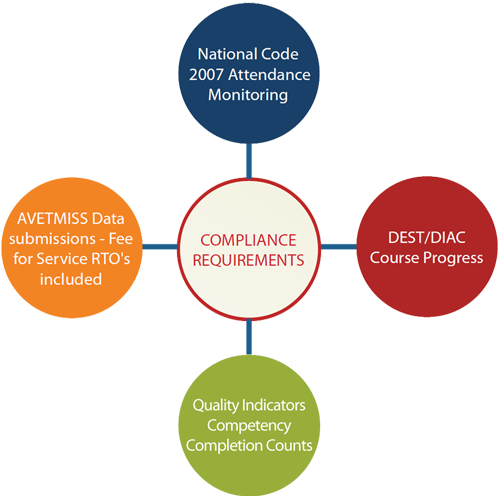Why Data Management is Essential for Every RTO?

Effective data management is essential for every Registered Training Organisation (RTO) to meet compliance requirements. This applies to RTOs of all types and sizes. A large amount of data is collected on a day-to-day basis, including information related to students, studies, employers, agents, schools, and more. This data plays a significant role in compliance requirements for RTOs. It is, therefore, essential to prioritize data management to meet compliance obligations and prevent potential issues in the future. The importance of data management for any RTO can never be overstated.
The Importance of Data Management
Data management is not something to avoid, and you need to put a plan in place to manage your data.
Firstly, take a step back and identify the compliance requirements to manage. Of these requirements, determine which ones mandate the storage and management of specific data. The main ones that are data specific include:

- Quality Indicator Competency Completion Counts
- AVETMISS data submissions.
It is therefore important to understand that failing to manage your compliance data properly will lead to a lot of compliance issues.
Understanding What Problem Data is
One of the biggest challenges for RTOs is identifying and correcting problem data — inaccurate, incomplete, or inconsistent information that disrupts compliance reporting and validation.
AVETMISS data submissions: A frequent issue in AVETMISS data submissions relates to student address details. Many systems allow users to type in suburbs manually instead of selecting from a verified list. While this may seem quicker, it often leads to invalid or inconsistent entries that fail validation during submission.
By mapping the student’s address to Australian Post’s website data, we validate the student address, especially their suburb, state, and post code.
We’d reject the first entry below:

melbourne, Victoria 3000

MELBOURNE VIC 3000
Another example for addresses
Many times, common suburbs like Melbourne, Sydney, Brisbane and so on, have all been entered into databases as melb, syd, bris etc., due to a lack of care by the person entering it. Another example for addresses is where the suburb, state, and post code are entered but no street address is entered or vice versa.
(Street Address Line 1) – left empty by staff member.

MELBOURNE VIC 3000

657 Elizabeth Street
MELBOURNE VIC 3000
Quality Indicators
Competency Completion Counts: especially think about the module activity file for started & completed counts. A student that is studying over more than one calendar year will NOT start or finish studying their competencies and/or modules in the one year and counting them in this way could have a dramatic completion count from one year to the next which can affect your Risk Rating.
DEST/DIAC course progress
This is CRICOS specific compliance but is very dependent on dates. RTOs must monitor a student’s performance/progress within each study period, how do you do this if you do not know when a student is meant to start and finish studying each of their competencies and modules? You can’t just count every competency/module a student must study over the entire duration of their enrolment where it is more than 26 weeks. The logic is that student’s do not start studying every competency/module at the commencement of their studies and finish them all at the end of their studies, they have different start and end dates typically based on your term/semester dates.
Typically for a CRICOS RTOs they never worried about recording a result date against the student’s competencies/modules as there was never a need so with the introduction of the above 3 compliance requirements for them meant many data nightmares and a lot of confusion and in some cases panic purely due to the amount of data they had.
National Code 2007
Attendance Monitoring: this is another CRICOS specific compliance requirement for RTOs but it also can impact ELICOS colleges if they have enrolments that are greater than 26 weeks as you must then separate it into different ‘study periods’ for monitoring.
As you can see all of the above are heavily reliant on dates yet many RTOs still do not understand the importance of this. You need to get your dates correct against a student’s course of study/enrolment so that you can manage the specific compliance requirements. Please don’t think that a date isn’t data, it absolutely is. And it isn’t just CRICOS RTOs that had problems with the introduction of these compliance requirements, many RTOs who chose the path of distance/ online learning, in a lot of cases to reduce and avoid as many compliance requirements as possible, also struggled when they realized they actually had to comply as well.
How to Improve the Quality of Your Data?
Most of your compliance-related data management revolves around a student and their studies — making student data accuracy the foundation of RTO compliance. Understanding where and how data is collected throughout the student life cycle helps you identify and manage potential risks.
There are three main stages in the student life cycle, each with distinct compliance requirements and critical data points:

Each one of these stages would mean you are collecting very specific, if not critical, data that impacts your compliance. For example:
Potential Students
During the application and enrolment stage, your RTO collects essential demographic, agent, and employer data. This information directly impacts AVETMISS reporting, so accuracy at this stage sets the foundation for all future compliance processes.
Active Students
This is the most critical phase for data management. Accurate and up-to-date information ensures smooth AVETMISS submissions, Quality Indicator reporting, and, for CRICOS RTOs, attendance and course progress monitoring.
Key data points include:
i) Competency/module start & end dates
ii) Results & Results issued dates
iii) Attendance
iv) Qualifications/Statement of Attainments issued
v) Withdrawals/deferments
Completed Student
Even after a student completes their studies, their data continues to influence AVETMISS outcomes and Competency Completion Counts. Ensuring accurate completion details supports clean reporting and audit readiness.
Steps to Strengthen Your RTO’s Data Management Process
For each stage of the student life cycle, it’s important to clearly define what data you collect, who enters it, and how it’s managed. This ensures your RTO maintains data accuracy and compliance consistency across all departments.
When reviewing your processes, ask the following key questions:
- What compliance-specific data is collected at this stage?
Identify which information directly affects your AVETMISS reporting, Quality Indicator submissions, or CRICOS compliance. - Who is responsible for entering this data?
Determine whether data entry is handled by a single staff member, multiple departments, or external agents. The more people involved, the greater the need for standardised procedures. - How is the data entered into your RTO system?
Review whether staff are entering information manually, importing from forms, or syncing from integrated systems. Each method has different risks and validation needs. - What improvements can be made to reduce errors?
Consider workflow changes, mandatory field validations, or automated tools within your RTO management software (like TEAMS) to enhance accuracy and efficiency.
By addressing these areas, your RTO can build a structured, repeatable process that maintains data integrity across all compliance activities.
Implementing and Maintaining High-Quality Data Practices
Once you’ve identified how and where data is managed within your RTO, the next step is to formalise your approach and ensure it becomes part of your organisation’s ongoing compliance culture.
Follow these key steps to strengthen your data management process:
- Update policies and procedures
Implement the necessary changes identified in your review. Update existing policies or create new ones to reflect improved data-entry standards and compliance safeguards. - Train your staff
Provide clear training on how data impacts compliance — especially AVETMISS submissions, Quality Indicators, and CRICOS requirements. Reinforce this responsibility through KPIs and performance reviews to ensure accountability. - Monitor data quality regularly
Conduct random daily or weekly data quality checks. A good rule of thumb is to review around 10% of all new data entries within that period. If recurring errors are found, revisit your processes to identify and address the root causes. - Review and refine policies
Regularly assess your data quality management policies to identify areas for improvement. As compliance requirements evolve, so should your procedures. - Understand your AVETMISS data files
Familiarise yourself with the structure and meaning of each NAT file. Over time, you’ll be able to quickly identify inconsistencies or missing information just by scanning the data — making validation faster and more reliable.
Consistent monitoring, training, and procedural improvement ensure your RTO maintains clean, compliant, and auditable data — reducing submission errors and improving overall operational efficiency.
The importance of data management: Assure with us
Effective data management is the foundation of every RTO’s compliance success. By ensuring your data is accurate, consistent, and regularly reviewed, you safeguard your organisation against compliance risks and reporting errors.
Take proactive steps — identify necessary improvements, update your policies and procedures, and train your staff on the critical role data quality plays in compliance reporting such as AVETMISS, Quality Indicators, and CRICOS monitoring. Regular data audits and continuous staff engagement will help maintain a culture of accuracy and accountability.
When your RTO prioritises data integrity, compliance becomes simpler, submissions run smoother, and the quality of your reporting improves across every area of operation.

